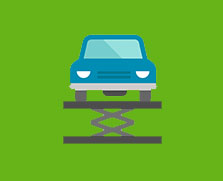Kia Venga MOT Results
Registered in 201787.2% pass rate
from 5,918 tests in 2021
Pass rate by mileage
More MoT Results
Failure rates by item
Here you can drill down into the failure rates for each item on the test. We've also compared the rates to the average results for 2017 cars and highlighted areas where the Kia Venga is unusually good or bad.
-
7.0% fail on
Visibility
(90% worse than other 2017 cars)
- 6.1% fail on Wipers (120% worse than other 2017 cars)
- 0.91% fail on Washers
-
0.10% fail on
Condition of glass
- 0.10% fail on Windscreen
-
0.017% fail on
View to rear
- 0.017% fail on Mirrors
-
2.0% fail on
Lamps, reflectors and electrical equipment
(25% better than other 2017 cars)
-
1.5% fail on
Headlamp aim
- 1.4% fail on Headlamp aim
- 0.084% fail on Headlamp aim not tested
-
0.24% fail on
Headlamps
(53% better than other 2017 cars)
- 0.24% fail on Headlamp
- 0.19% fail on Stop lamp
-
0.10% fail on
Direction indicators
-
0.10% fail on
Flashing type
- 0.068% fail on Side repeaters
- 0.034% fail on Individual direction indicators
-
0.10% fail on
Flashing type
-
0.068% fail on
Electrical equipment
- 0.034% fail on Battery(ies)
- 0.034% fail on Horn
-
0.017% fail on
Position lamps
- 0.017% fail on Position lamp
-
0.017% fail on
Front and rear fog lamps
-
0.017% fail on
Rear fog lamp
- 0.017% fail on Rear fog lamp
-
0.017% fail on
Rear fog lamp
-
0.017% fail on
Mandatory tell-tales
- 0.017% fail on Rear fog lamp tell-tale
-
1.5% fail on
Headlamp aim
-
1.7% fail on
Tyres
(50% better than other 2017 cars)
- 1.4% fail on Condition (30% better than other 2017 cars)
- 0.39% fail on Tread depth (75% better than other 2017 cars)
- 0.017% fail on Size/type
-
1.3% fail on
Brakes
(38% better than other 2017 cars)
-
0.74% fail on
Mechanical brake components
(50% better than other 2017 cars)
-
0.56% fail on
Brake linings and pads
(55% better than other 2017 cars)
- 0.56% fail on Brake pads (55% better than other 2017 cars)
-
0.25% fail on
Brake discs and drums
- 0.25% fail on Brake discs
-
0.56% fail on
Brake linings and pads
(55% better than other 2017 cars)
-
0.51% fail on
Brake performance
-
0.35% fail on
Service brake performance
-
0.35% fail on
Rbt
- 0.34% fail on Service brake performance
- 0.017% fail on Service brake imbalance
-
0.35% fail on
Rbt
-
0.068% fail on
Service Brake Efficiency (sp)
-
0.068% fail on
Rbt (sp)
- 0.034% fail on Service brake performance
- 0.034% fail on Service brake imbalance
-
0.068% fail on
Rbt (sp)
-
0.068% fail on
Parking brake efficiency (sp)
- 0.068% fail on Rbt (sp)
- 0.017% fail on Brake performance not tested
-
0.017% fail on
Parking brake performance
-
0.017% fail on
Rbt
- 0.017% fail on Parking brake performance
-
0.017% fail on
Rbt
-
0.35% fail on
Service brake performance
-
0.051% fail on
Brake actuators (including spring brakes or hydraulic cylinders)
- 0.051% fail on Hydraulic brake callipers
-
0.034% fail on
Hydraulic systems
- 0.017% fail on Reservoirs
- 0.017% fail on Brake fluid
- 0.017% fail on Valves
-
0.017% fail on
Service brake pedal or hand lever
- 0.017% fail on Pedal
-
0.017% fail on
Parking brake control
- 0.017% fail on Lever
- 0.017% fail on Rigid brake pipes
-
0.017% fail on
ABS / EBS / ESC
- 0.017% fail on Anti-lock braking system
-
0.74% fail on
Mechanical brake components
(50% better than other 2017 cars)
-
0.32% fail on
Suspension
(64% better than other 2017 cars)
- 0.20% fail on Shock absorbers
- 0.084% fail on Wheel bearings
-
0.017% fail on
Suspension arms
- 0.017% fail on Ball joint dust cover
-
0.017% fail on
Anti-roll bars
- 0.017% fail on Ball joint
-
0.27% fail on
Seat belts and supplementary restraint systems
-
0.24% fail on
Seat belts
- 0.15% fail on Condition
- 0.051% fail on Attachment (14 times worse than other 2017 cars)
- 0.034% fail on Requirements (5 times worse than other 2017 cars)
- 0.034% fail on SRS malfunction indicator lamp
-
0.24% fail on
Seat belts
-
0.19% fail on
Identification of the vehicle
- 0.19% fail on Registration plates
-
0.15% fail on
Body, chassis, structure
- 0.051% fail on Bumpers
-
0.034% fail on
Body
- 0.034% fail on Other body component
-
0.017% fail on
Integral vehicle structure
- 0.017% fail on Integral vehicle structure condition
- 0.017% fail on Exhaust system
-
0.017% fail on
Doors
-
0.017% fail on
Front passenger's door
- 0.017% fail on Door condition
-
0.017% fail on
Front passenger's door
-
0.017% fail on
Seats
- 0.017% fail on Driver's seat
-
0.10% fail on
Noise, emissions and leaks
(82% better than other 2017 cars)
-
0.068% fail on
Exhaust emissions
(87% better than other 2017 cars)
-
0.068% fail on
Compression ignition
(69% better than other 2017 cars)
- 0.068% fail on Malfunction indicator lamp
-
0.068% fail on
Compression ignition
(69% better than other 2017 cars)
-
0.034% fail on
Fluid leaks
- 0.034% fail on Engine oil leaks
-
0.068% fail on
Exhaust emissions
(87% better than other 2017 cars)
-
0.068% fail on
Road Wheels
- 0.034% fail on Condition
- 0.034% fail on Attachment
-
0.034% fail on
Steering
-
0.017% fail on
Steering linkage components
- 0.017% fail on Track rod end
-
0.017% fail on
Power steering
- 0.017% fail on Operation
-
0.017% fail on
Steering linkage components
-
0.017% fail on
Seat belt installation check
- 0.017% fail on Belt(s)/padding
Read the Honest John Review
-
.jpg?width=120&height=72&rmode=crop) Kia Venga (2010 - 2019)
Spacious back seats and wide-opening doors. Easy to drive and park. Good visibility. Decent boot capacity.
Kia Venga (2010 - 2019)
Spacious back seats and wide-opening doors. Easy to drive and park. Good visibility. Decent boot capacity.




